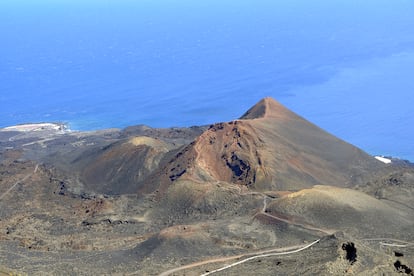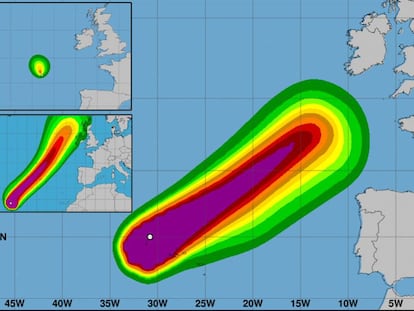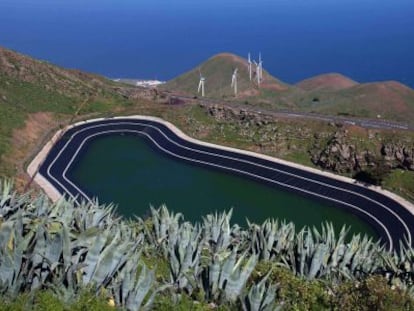Authorities warn of possible volcanic eruption on Canary Island of La Palma
Since September 11, more than 4,200 tremors have been recorded in the area near Teneguía volcano, and they are reportedly growing in intensity

In October 2011, following weeks of intense seismic activity, an underwater volcano erupted off the coast of El Hierro in Spain’s Canary Islands. Ten years later, the nearby island of La Palma appears to be facing the same situation. In the past few days, more than 4,200 tremors have been recorded and a ground deformation indicates that magma is bubbling beneath the surface.
The team of experts monitoring the phenomenon, the Volcano Risk Prevention Plan (Pevolca), says it is possible that this magma could cause a volcanic eruption on the surface in the next few days or weeks. But while the process has intensified, there are no clear signs of an imminent eruption. For this reason, Pevolca decided on Tuesday to elevate the risk of a volcanic eruption to yellow – the second-highest in the three-tiered system.
“We cannot make a short-term forecast,” warned María José Blanco, the director of the National Geographic Institute (IGN) in the Canary Islands. “But everything indicates that it will evolve into earthquakes of larger magnitudes that will be more intense and felt by the population.”
The last eruption in La Palma took place in October 1971, when the Teneguía volcano spewed out lava for more than three weeks after a crack appeared in the south of the island. The situation remained calm until 2017, when seismic activity resumed. In the past few days, this activity has intensified with constant small tremors, known as an earthquake swarm, recorded a few kilometers from Teneguía in the Cumbre Vieja area, southeast of the island.
This earthquake swarm began on September 11, and since then, more than 4,200 tremors have been detected. Nearly all have been of small magnitude, but on Wednesday there were four that measured more than 3 on the Richter scale. What’s more, the tremors are also becoming closer to the surface, which indicates that magma is looking to escape. While the first earthquakes were recorded at more than 20 kilometers below the surface, on Wednesday, they hit at a depth of between six and eight kilometers. Indeed 20 tremors were recorded at just three kilometers below the surface. Another sign of the pressure is that, in the area of the earthquake swarm, the island has swelled six centimeters – 4.5 centimeters on Wednesday alone.
Blanco said that the phenomenon is “very powerful” compared with the situation in El Hierro 10 years ago: the tremors in La Palma have released as much energy in the space of three days as that released during the weeks of eruption in 2011. Nevertheless, Blanco said that an eruption was not “imminent” as the process is ongoing. “There still has not been a large earthquake that opens a path for the magma, which is at a depth of eight kilometers, which would cause tremors by breaking the Earth’s crust to reach the surface,” she explained.
Authorities have called for calm, but have also asked the population to remain alert. The municipalities affected by the yellow warning issued on Tuesday are Fuencaliente, Los Llanos de Aridane, El Paso and Mazo.
The Pevolca committee also warned that “earthquakes of larger intensity are to be expected.” The head of the government administration of La Palma, Mariano Hernández Zapata, said on Wednesday that he was not ruling out any fast changes in the situation that could lead to an eruption in the “short term.” “We are living on a volcanic island and [an eruption] is one of the options that could happen,” said Hernández, after speaking of the experience of Teneguía.
Luca D’Auria, the head of the Volcano Monitoring Department at the Canary Islands Volcano Institute (Involcan), said that, based on what is known about the geological history of La Palma, “magma builds up in an area that is five kilometers below the surface before entering into an eruption.” “What’s most likely is that the magma has found a way toward the surface and it is very likely that it will end up reaching it,” he explained. According to D’Auria, the situation is evolving “very quickly” – faster than what was recorded in El Hierro in 2011, when earthquake swarms took place for weeks before the eruption. Although the expert admitted it could “amount to nothing,” he argued that it was likely that an eruption will happen in the areas being hit by earthquakes, “but we don’t know yet.”
English version by Melissa Kitson.
Tu suscripción se está usando en otro dispositivo
¿Quieres añadir otro usuario a tu suscripción?
Si continúas leyendo en este dispositivo, no se podrá leer en el otro.
FlechaTu suscripción se está usando en otro dispositivo y solo puedes acceder a EL PAÍS desde un dispositivo a la vez.
Si quieres compartir tu cuenta, cambia tu suscripción a la modalidad Premium, así podrás añadir otro usuario. Cada uno accederá con su propia cuenta de email, lo que os permitirá personalizar vuestra experiencia en EL PAÍS.
¿Tienes una suscripción de empresa? Accede aquí para contratar más cuentas.
En el caso de no saber quién está usando tu cuenta, te recomendamos cambiar tu contraseña aquí.
Si decides continuar compartiendo tu cuenta, este mensaje se mostrará en tu dispositivo y en el de la otra persona que está usando tu cuenta de forma indefinida, afectando a tu experiencia de lectura. Puedes consultar aquí los términos y condiciones de la suscripción digital.
More information
Últimas noticias
Daytime, headphones, no booze involved: How a generation is saying ‘no’ to club parties
Millennia-old Yuracaré language resists extinction through 900 speakers and a new dictionary
Susan Boyle prepares a comeback just as Timothée Chalamet sings her praises
Trump suspends green card visa lottery after shooting at Brown University
Most viewed
- Christian Louboutin: ‘Young people don’t want to be like their parents. And if their parents wear sneakers, they’re going to look for something else’
- US sanctions against jailed cartel leader ‘El Marro’ highlight Mexico’s lack of control over its prisons
- Cartels in Mexico take a leap forward with narco-drones: ‘It is criminal groups that are leading the innovation race’
- Liset Menéndez de la Prida, neuroscientist: ‘It’s not normal to constantly seek pleasure; it’s important to be bored, to be calm’
- ‘El Limones’ and the growing union disguise of Mexican organized crime











































